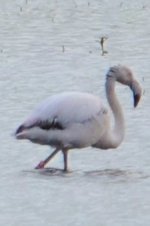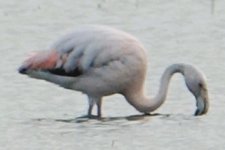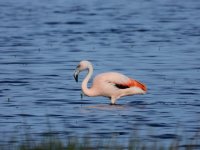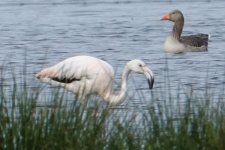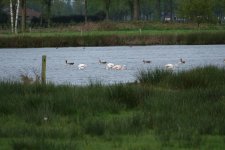Tnx guys. I had to do research myself and I found some good sites but sorry, so far all in Dutch.
So far I find four species occured in Western Europe and the Netherlands. Chilean, Greater, American/Caribbean and Lesser Flamingo. The Chilean and the Greater are the dominant species, the other two were only found in very small numbers until 2015. Is is thought that Chilean and American were brought here in capitivity and released or escaped, although it still is possible that few of them came over the Atlantic. The other two could have flown here from Africa etc.
The colony on the German border, as Jurek mentioned above, happens to be the only breeding place in North-Western Europe . With a maximum of roughly 50 specimens around April/May. First the Chilean arrived (until 1985), from 1986 the Greater and after 1994 some American. The three species formed a breeding colony together, with some hybrids as a result also, but still most of them are whether Chilean or Greater. The few Lesser F. that arrived near the same place are not part of that and probably do not breed in Western Europe at all.
For example: in a certain year there were 6 pairs of Chilean and 6 pairs of Greater Flamingo breeding, plus one hybrid, in the colony in Germany.
In winter when the colony can't find enough food in the area they fly elsewhere, to several places around Germany, Holland and Belgium or even a few to the other breeding places in France, Spain and Africa. Since 2000 there are more of F. to be found foraging outside the breeding area at German Zwillbrocker Venn , probably because of food abundance elsewhere. In some years no chicks survived due to foxes, but authorities took measures to protect them. All young birds get ringed before they fly out and at least one of the four I photographed yesterday had a ring we think. Big chance these four come from that German border colony I would say.
It is suggested by some that the three Phoenicopterus species here better should be considered as one species, since they are very close related and interbreed occasionally therefore could be too difficult to distinguish from each other. Maybe that is true, although one can find pure specimen of each of the three in their original setting and look for the differences. Hybrides are much harder to distinguish however. Many Dutch observers write down Phoenicopterus indefinite at their obs. For best identification it is best to determine when they fly I read.
However from a useful scheme in
https://flamingosinnederland.info/w...eling-determ.-en-naamgeving-bij-flamingos.pdf (in Dutch) I selected following details:
Chilean Flamingo - grey/green legs but yellow in breeding time, red heel joints and feet, beak cream white and black from the nod, shorter neck and legs, body light pink
Great Flamingo - unicolour dark pink legs, joints and feet, beak dark pink with small, black tip, longer neck and legs, mainly white body
The pink colour indeed comes from carotenoids in the food, more precise: Astaxanthine. They go white or grey without that substance. There are unlimited mixes of grey, white, pink and red because of that. Overall there is quite some information and research done on the Flamingo's in Europe.
Based on these details it looks like these probably are four Chilean Flamingo's in both series of photo's. There were only four anyway. In the very first pic there is no pink feet visible, the neck is shorter and the body not white enough for Greater I think. An the beak is by no way as pink as on the pics I find of the Greater F. So I think it is still possible to ID these birds, takes only quite some effort...






